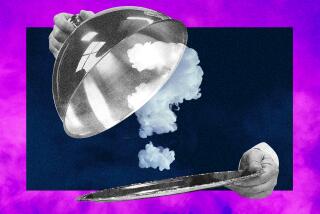A License to Chill
Do you medicate? I do.
I’m not talking about Xanax or Prozac or Vicodin or their siblings. I have a “recommendation” (not a prescription, a recommendation) for pot. This puts me in a legally and socially problematic condition. The state of California says I can ingest marijuana for medicinal purposes, but the U.S. Drug Enforcement Administration thinks I’m a criminal if I do. Because THC can make you feel good when you’re healthy as well as feel better when you’re sick, people who don’t know me might see me as a big-bong punch line, in a Cheech and Chong kind of way. If you pop Viagra, you’re tough and sexy; if you smoke weed, you’re half-baked. I’ve been an occasional user of pot for 30 years. Only in the past six months have I done so without risking arrest, at least as far as Sacramento is concerned. It was very easy to become a medical user, but it raised a question: Was I better off breaking the law? In Los Angeles County a recommendation can be filled at more than 100 dispensaries, many of which have been raided by the DEA. Proposition 215, the first of its kind in the nation, went into effect in 1996 and prohibits a doctor from being punished for having recommended marijuana to a patient who is “seriously ill.” A 2003 law requires the state Department of Health Services to “establish and maintain a voluntary program for the issuance of identification cards to qualified patients.”
I was aware of these laws long before last summer but hadn’t felt the urge to take advantage of them until someone stuck a flier under my windshield. It was from California Natural Pain Relief on Ventura Boulevard in Studio City, and it informed me, misspellings and all, that “Medical cannabis can be recommended for the care and treatment of Cancer, Cronic pain, arthritis, Migraines, Diabetes, Insomnia, Anxiety, Aids Nausea, Epilepsy, Lupus, Depression, Eating Disorders, Menopause, PMS, Asthma, etc.”
When I visited California Natural Pain Relief, the folks there directed me to a doctor at another office. Since I experience occasional but painful attacks of gout, a form of arthritis, as well as other foot and knee pain, I brought a load of medical records and a vial full of Vioxx that I had been too scared to take. The doctor gave me a brief physical exam and a blood pressure test, discussed how marijuana could alleviate the pain and inflammation and wrote and signed an official-looking, green-trimmed recommendation. This included the doctor’s signature, a photocopy of my driver’s license and a key phrase: “approve of the use of cannabis for my patient.” I paid $150 cash.
Armed with my license to chill, I drove back to Ventura Boulevard, smiled at the beefy bodyguard, strolled inside and handed the recommendation to the dispensary operator. There was a faintly agricultural scent in the air. Under a glass countertop were vials labeled Master Kush, Cotton Candy and OG Kush; also on display were variants of cannabis strains known as chronic and ganga. I forked over $50 for an eighth of an ounce and received a small pipe as a new-patient gift.
Later, when I told a friend about my purchase, he laughed and delivered the ultimate insult: “You paid more than street value.”
My solace was that my uncontrolled substance use was sort of legal. L.A. lawyer Allison Margolin, who calls herself “America’s dopest attorney,” explained that my recommendation wasn’t above-board in the eyes of the feds. But could they go after me if they found physician-recommended pot in my house? They could, but “no judge is going to pursue it,” she said.
Margolin represents marijuana growers as part of her criminal defense practice. They are, she told me, “the bigger risk-takers in the system,” because although the DEA might not bother with the likes of me (and hopefully not with people who are terminally ill), it does bother with Californians who cultivate pot destined for dispensaries and with the dispensaries themselves.
It isn’t something many medical marijuana users spend a lot of time worrying about. “People have gotten very comfortable with the level of access in Los Angeles,” said Stephanie Landa, who’s serving a 41-month federal prison term for cultivating marijuana. But they don’t stop to think when they’re consuming their medicinal pot that “it didn’t just fall out of the sky. It had to come from somewhere.”
Speaking of consuming, medicinal weed isn’t only inhaled. There’s a contingent of bakers and candy makers in the alternative pharmacy universe who produce marijuana edibles. I’ve tasted several varieties, including a canna-brownie with crisp vanilla icing from Cotton Mouth Confections, which was delicious and chocolaty, and a baklava that was less enjoyable, the bottom tasting like a mouthful of buds.
With edibles, I never knew how much THC I was actually putting into my system. One evening I ate half a brownie after dinner and couldn’t get to sleep until 2 a.m. I felt anxious and dizzy. I got lost in the darkness, spinning in the corridor between the bedroom and the bathroom. At the movies I downed a My Kushbar (a concoction of dark chocolate, blueberries and crisp rice), and my wife had to poke me as I sat catatonically watching “Dreamgirls.” I shook my head and handed her the car keys.
Then there was the Volcano Vaporizer, a stainless-steel device shaped like an Apollo space capsule. It works like this: You attach a plastic balloon to the capsule, light the device, and the THC goes into the bag. Take the bag off, push on a black valve, and vapor—not harsh smoke—blows into your mouth. There’s little odor and a highly efficient high. So efficient that later at the gym (don’t worry, I walked there) I almost had a Janet Jackson exposure moment as I started to whip off my cargo shorts only to discover I’d forgotten my gym shorts. My trainer muttered, “You’ve convinced me you’re going to have a heart attack,” and threatened to fire me as a client.
Marijuana did help calm my foot-pain problems. Also, my appreciation of everyday beauty was enhanced. At Balboa Park, the end-of-summer foliage and the grass, sky and late-afternoon pollution around the sun appeared in Technicolor sharpness. At the same time, I was anxious and confused. I hadn’t taken so much pot in years. For six months (in the spirit of scientific inquiry) I consumed maybe one gram every two weeks; my previous marijuana purchases had been on the order of a quarter-ounce every two or three years through the usual friend-of-a-friend channels.
When I started smoking pot on the East Coast in the ‘70s, I remember the choices being basically Jamaican, Colombian and skunkweed. Today the strains are dizzying in variety and power, and all are available at the dispensaries. It’s a real business: The Los Angeles Journal for the Education of Medical Marijuana, a free monthly, lists doctors, collectives and lawyers and covers events such as the 2006 DOESHA Cup, a tasting event in which California marijuana growers compete. It’s all a bit overwhelming for a boomer.
Is Los Angeles the Amsterdam of America? Not quite. Dispensaries aren’t coffee shops, as they’re called in the Netherlands, where pot is sold and consumed as casually as beer is here. Dispensaries are more like cash-and-carry package stores in states that control liquor sales. Another party stopper: Sharing or reselling a patient’s medical cannabis is illegal.
Some dispensaries try to make it all seem like a party, though. They advertise with slogans such as “KushMart: Where It’s 4:20 Always” (4:20 being shorthand for smoking pot or getting high—and, incidentally, the number of the 2003 state Senate bill). There’s also a maybe-not-so-clever propensity for employing words such as “therapeutic” and “herbal” and “compassion”—so that the initials of dispensaries, including Therapeutic Health Care and Today’s Holistic Caregivers, are THC.
I found one outfit that doesn’t mess with any of that: The Natural Relief Center in Canoga Park, which doesn’t advertise and shuns windshield fliers. Owner Michael Levitt got into the business one year ago. “I was comfortably retired,” he told me, “but my wife didn’t like me around the house so much.” What motivated him were myriad health problems, including diabetes and high blood pressure. “At 51 years old, it doesn’t wear well to deal with street thugs to get medication. I thought I could help people and bring the game up as a businessman.” He described his storefront as “a community spot.” There’s a hairdresser on one side and a newsstand on the other.
In L.A., City Councilman Dennis Zine of the West Valley wants dispensaries to be located in industrial, commercial or business areas, “where they’re not going to have an impact on young people.” I’m all for that. (By the way, the City Council’s Planning and Land Use Management Committee voted in January in favor of enacting a moratorium on new dispensaries until the city devises rules governing them.)
I learned a lot during my months as a medical marijuana user and came to three conclusions: My tolerance is low; pot should be legal as a pain reliever; the distribution system in place right now has room for improvement. But it’s like Winston Churchill said about democracy—it’s the worst form of government, except for all the others.
More to Read
Get the L.A. Times Politics newsletter
Deeply reported insights into legislation, politics and policy from Sacramento, Washington and beyond. In your inbox three times per week.
You may occasionally receive promotional content from the Los Angeles Times.






